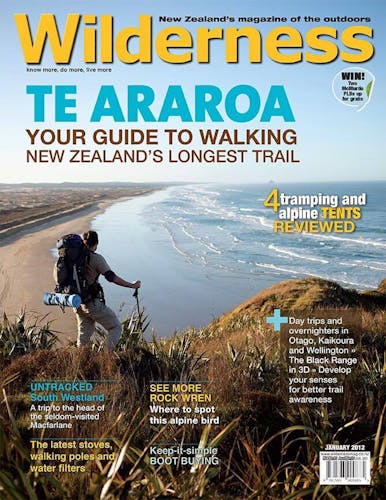Letter of the month
Children thrive in the outdoors
I was pleased to read the article ‘Next trip, take the kids’ (December 2011).
I think that as a society we are not letting our children have many ‘risky’ adventures in case they hurt themselves. In the bush, any child of average ability can spend many happy hours or days amusing themselves and finding out about the country that we live in. When they get older they will remember the night they cooked sausages over the fire or saw a kiwi in the wild and even the exhilaration of getting to the top of a distant hill and seeing the wonderful views spread out below. Planning is essential and normal precautions should be taken but the end result is a very capable child able to look after themselves in the backcountry.
As a long-distance hiker, I have been amazed at the resilience of the young children I have observed and spoken to ‘in the middle of nowhere’. They usually carry all their own personal gear and are very capable.
There is a fascinating book about a couple who thru-hiked the 4300km Pacific Crest Trial in the USA with their 10 year-old daughter. Zero Days by Barbara Egbert portrays the trials and tribulations of this close-knit family on their six month journey. They had started taking their daughter hiking with them a few months after she was born so she was not afraid of the outdoors, in fact she was very comfortable in that situation. There were risks galore but they coped and they conquered the trail.
So get out there with your children and enjoy the wonderful New Zealand outdoors.
– John Craig, Wellington
DOC ignoring the masses
In the story ‘Hut network on the operating table’ (October 2011), the Department of Conservation says it wants to increase the usage of DOC huts and facilities.
If DOC is serious about this, it should look at its policy of providing few facilities for the 50 per cent of the population that live north of Lake Taupo.
At the moment only six per cent of DOC huts exist north of Taupo. Simple little huts such as Moss Creek, Wairere, Waiwawa, Te Aroha and Mangakino have burnt down or been taken out despite opposition from local trampers and never been replaced.
In contrast, luxurious Anne Hut and Siberia Hut in the South Island have been replaced within months of being destroyed by fire.
The Auckland Associated Mountain Clubs is very concerned at this huge imbalance of resources. If DOC provides more huts in the north, they will be well used and provide extremely valuable physical and mental health services for the populations of Auckland, Hamilton and Tauranga.
– Bryan Dudley, President Auckland Associated Mountain Clubs
Cape Brett Track no walk in the park
In the article ‘perfect Weekends’ (December 2011), the Cape Brett track in Northland is rated as ‘easy’. I don’t believe this is the case and would not like to see people misled and find themselves in a struggle to reach the hut.
It is recorded as moderate to hard in other publications. I’ve done the track a couple of times with a tramping group and consider myself of above average fitness. Most of us relish a day in between getting to the hut and walking out to recharge.
I do recommend people do this track if given the chance. The view as you come over the last hill is amazing and worth all the hard yards to get there. The hut is spacious and comfortable, the sunsets are incredible and swimming with the seals is a great experience. Fishing for your breakfast is a must if you take a rod.
– Sandra Whyte, e-mail
Forestry and ‘dirtying rivers’
In Fraser Crichton’s article ‘They’re just photos, man’ (October 2011) he quotes Craig Potton as saying fertilisers, herbicides and pesticides dropped on the land, as part of our dairying and forestry industries are “plain dirtying rivers”.
Being a forester, I would like to ask how ‘fertiliser, herbicides and pesticides’ can be linked with the forestry industry and dirty rivers?
Plantation forestry uses very little fertiliser (only on a few sites with nutrient deficient soils); herbicides are used for a year or two after harvest, prior to replanting (once every 25-30 years); and pesticides are rarely used at all (in many cases less frequently than in native forests, as most large companies are now FSC certified, which does not allow for the aerial use of the likes of 1080).
There can certainly be increased risk of sediment loss into rivers two-five years after harvesting, particularly following severe storms, but there is overwhelming evidence that forest planting reduces hill country erosion significantly compared to pastures (by up to 90 per cent).
Likewise, there is much research showing that nutrient leakage from forests is significantly less than from grazed pasture – particularly dairying.
When it comes to water quality, there is no way one can compare forestry with dairying relative to ‘plain dirtying rivers’.
– Nick Ledgard, Rangiora






